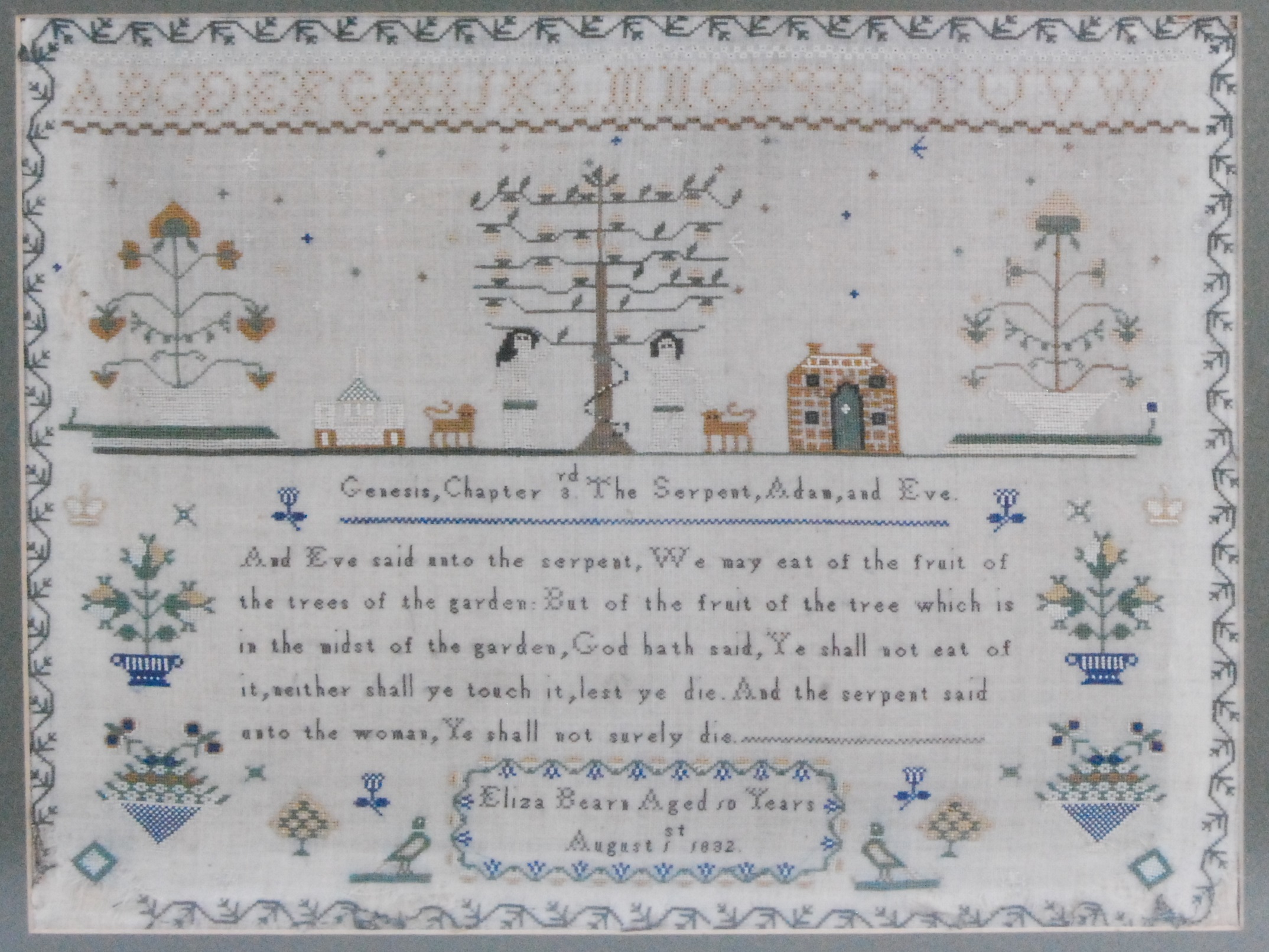The tragic tale of the Bearn family
 This William IV needlework sampler depicting The Fall of Adam and Eve in Genesis is signed by a 10-year-old Eliza Bearn who completed the piece in 1832. According to the vendor, this is the same Eliza Bearn whose unfortunate family are remembered for a string of tragedies ranging from death in childbirth to child mortality, alcoholism, poverty, and finally the infamous death of her stepmother by execution - the last woman to be publicly hanged in Dorset and inspiration for Thomas Hardy’s Tess of the D’Urbervilles.
This William IV needlework sampler depicting The Fall of Adam and Eve in Genesis is signed by a 10-year-old Eliza Bearn who completed the piece in 1832. According to the vendor, this is the same Eliza Bearn whose unfortunate family are remembered for a string of tragedies ranging from death in childbirth to child mortality, alcoholism, poverty, and finally the infamous death of her stepmother by execution - the last woman to be publicly hanged in Dorset and inspiration for Thomas Hardy’s Tess of the D’Urbervilles.
According to the Find A Grave website, Netherbury-born butcher Bernard Bearn married Elizabeth Mawson, the illegitimate daughter of a local yeoman, at Powerstock, Dorset, in 1821. Young Eliza was born the following year. A son, James, followed in 1823. The heartbreak begins here, as Elizabeth died in childbirth, leaving Bernard a widower with two young children.
In 1831, at the age of 39, Bernard married 20-year-old Elizabeth Martha Clark, who was mostly known as Martha. The couple had two sons; William, born in 1832, and Thomas, born 1834. Disaster struck again in 1835, when both of these sons died from an unspecified disease, possible measles or smallpox – child mortality rates were a shockingly high approximately 40% in this period. This was swiftly followed by the death of elder son James from Bernard’s first marriage, after falling from a tree just six months later.
This series of devastating blows obviously hit the couple hard. Bernard began drinking heavily and lost his role on the local Board of Guardians. According to the information provided, Bernard turned against Eliza, his only remaining child, because of her treatment of her brother before his death. More likely, grief and financial difficulties meant that the couple were no longer in a position to raise their daughter, and she went to live with her maternal aunt. Their situation worsened and Bernard became increasingly ill and despondent.
Some time later, Bernard received news from his sister-in-law that young Eliza had run away to London with a farm labourer. Full of regret, Bernard set off in search of Eliza despite his ill health. Sadly, the long arduous journey was to be fruitless and end in tragedy. Bernard was found collapsed on a street in Southampton and died of pneumonia in the local workhouse on 15th February 1841. It appears that Eliza Bearn was never found.
The now widowed and childless Martha eventually remarried in 1852. Her new husband John Brown was 20 years her junior and, according to her later testimony, a drunk and a philanderer.
In the early hours of 6th July 1856, Martha banged on the windows of her neighbours’ house stating that John had been kicked to death by his horse. After investigation by neighbours and police officers of the scene of death, it was clear that all was not as it seemed, and Martha was brought to trial and found guilty of murder. In her confession of 7th August, Martha claims that her husband returned drunk late at night and proceeded to whip and beat her, whereupon she took up the handily placed coal hatchet and beat him about the head. She finishes by stating “I had never struck him before after all his ill treatment, but when he hit me so hard at this time I was almost out of my senses, and hardly knew what I was doing."
Two days later, Martha became the last woman to be publicly executed outside Dorset County Gaol in Dorchester. Amongst the crowd of over 3000 spectators was 16-year-old Thomas Hardy, who was so appalled and inspired by the occasion that he based his character Tess of the D’Urbervilles experience on her in the novel published in 1891. He later wrote that he was ashamed to have been at the execution.
Whether this needlework was actually embroidered by the same Eliza Bearn related to such a tragic family, we’ll probably never know, but researching personal items such as this do give us an insight into the actual lived experiences of our ancestors and I for one find them fascinating, if heartbreaking.
The sampler will be lot 1294 in our 12th September Fine Art auction.





